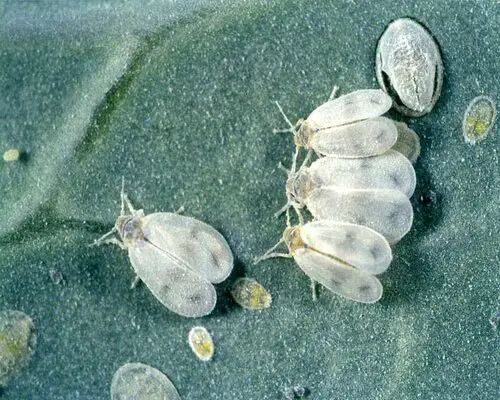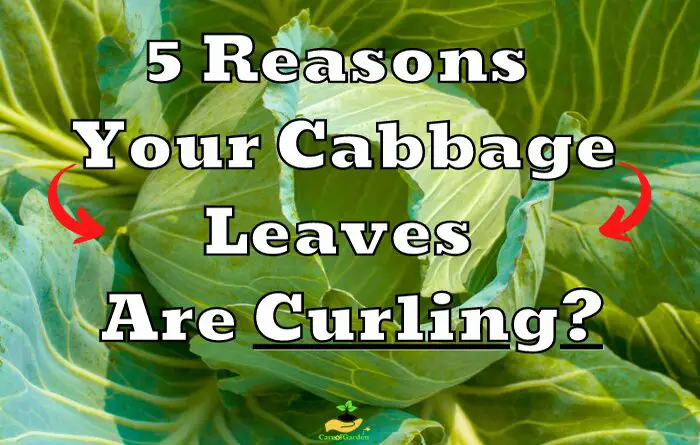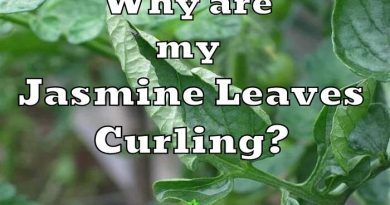5 Reasons Your Cabbage Leaves Are Curling? (& How To Fix It)
Cabbage is one of the most common vegetables grown and leaves curling is a common problem faced not only by novice gardeners, but also by experienced gardeners. Many do not know what to do and all want to know the answer for this question: Why are Cabbage Leaves Curling?
Cabbage leaves can curl due to the harmful activity of certain pests (aphids, whitefly), due to a lack of moisture and/or due to nutrients deficiency.
Reasons Cabbage Leaves are Curling
| Why are Cabbage Leaves Curling: |
|---|
| 1. Cabbage Aphid |
| 2. Cabbage Whitefly |
| 3. Lack of Moisture |
| 4. Temperature Stress |
| 5. Nutrients Deficiency |
1. Cabbage Aphid

The main reason cabbage leaves are curling is the invasion of cabbage aphids (Brevicoryne brassicae). These small insects having a gray-white color prefer to live in large colonies and feed on cabbage leaves by biting and sucking their juices. As a result, the leaves start to curl and the head formation of the cabbage is damaged as a result.
The mealy cabbage aphid (Brevicoryne brassicae) from the tube aphid family (Aphididae) occurs mainly in hot and dry summers on cabbage and Brussels sprouts.
From April/May colonies of gray-green, white-powdered aphids cavort under the leaves, sucking on the leaves of the cabbage plants. Overwhelmed by such an invasion, cabbage quickly loses its vitality. The leaves become stained and start curling.
Before the onset of winter, cabbage aphids lay innumerable eggs both on cabbage stumps and on weeds growing nearby. In the spring, aphid larvae are born from overwintered eggs, which develop into adult females after about 10-14 days.
These in turn bring new offspring. As a result, even the most extensive cabbage bed is completely infested with cabbage aphids in a relatively short time.
During one season, more than 16 generations of aphids grow on the site, and both larvae and adult insects use cabbage juice for food. Overwhelmed by such an invasion, the cabbage quickly loses its vitality, its leaves become brown, curl up, and over time the cabbage dies.
Aphids reproduce particularly actively in moderately humid and warm weather, so gardeners need to be especially careful in warm, rainy summers.
Treatment
Beneficial insects such as ladybugs or parasitic wasps can keep a light aphid infestation in check.
Make sure to regularly inspect the underside of cabbage leaves starting in mid-summer. Intensive reproduction of aphids occurs at the end of summer, it is during this period that the pest poses the greatest danger.
In the autumn, the last generation of aphids lays black eggs on the cabbage for the winter.
The first step is to plow the soil where cabbages were planted so that the aphid eggs have no chance of surviving the frost.
Secondly, to reduce the number of aphids, you can use their natural predators like ladybugs, lacewings and hoverflies.
Thirdly, when the first signs of aphid damage are detected, it is necessary to start treating the leaves with insecticides: A mixture of 5 grams of potassium chloride and 10 grams of superphosphate extract is usually used for the first treatment, which are dissolved in 10 liters of water and sprayed on the cabbage leaves.
Homemade treatments can be made using: infusions of potato tops, tobacco dust, onion peel and ash are used. Treatment with such infusions can be carried out two to three times per season at intervals of one to one and a half weeks.
To keep the mealy cabbage aphid away from your vegetables in the future, it is best to cover your cabbage plants with a dense crop protection net.
2. Cabbage Whitefly

Cabbage Whitefly is a common pest present on the cabbage leaves. They look like a small moth up to 1.5 mm long with white wings and two dark spots on them.
Their larvae (nymphs) are flat, oval, whitish-green, attached to the lower surface of the leaf.
Both adult insects and larvae mainly settle on the inside of the cabbage leaf. They begin to suck out the juices of the plant, which will lead to curled leaves and soon after a black fungal coating will appear.
If nothing is done, then this can lead to complete cabbage death, which is why it is important to know how to treat whitefly cabbage.
With a prolonged infestation of whiteflies, you can see that cabbage leaves begin curling, turning black and the process of photosynthesis practically stops. Because of this, the plant slows down in growth and development.
When whiteflies have colonized the cabbage thoroughly, they are easy to detect: they will startle if you shake the foliage.
To prevent the appearance of the cabbage whitefly, it is recommended:
- Destruction of weeds on cabbage crops and near them.
- Preventive checkups on cabbage leaves .
The fight against the whitefly is difficult, because its larvae, covered with a wax coating, cannot be treated with chemicals.
Treatment
The cabbage whitefly is not easy to control, especially if there are affected plants in neighboring areas that can become a source of recolonization.
Fortunately, the cabbage whitefly only affects the outer leaves and usually causes little actual damage to the interior of the plant.
Here are three methods to combat cabbage whiteflies:
- Between the rows of cabbage, place yellow traps with a sticky substance, such as honey or wood glue: the pest will be attracted by the yellow color, and it will no longer be able to tear itself away from the sticky surface.
- Wash the plant leaves with a solution of laundry soap (100 g of soap per 10 liters of water).
- Treat the cabbage with garlic infusion. You can cook it according to this recipe: pour 10 heads of garlic with 5 liters of water for half an hour, then bring to a boil and cook for 2 hours over low heat. Remove the pot from the heat, leave covered until cool, then strain and sprinkle over the cabbage heads. Repeat every week.
3. Lack of moisture
Curled leaves on cabbage are a sign of lack of moisture. Lack of water will lead to a loss of turgor, making the cabbage leaves lose elasticity and twist along the central vein.
Cabbage requires abundant watering when heads are tied and growing. The soil moisture regime should be adjusted to prevent the soil from drying out.
In this case, you need to pour and loosen the soil well, and lay a layer of mulch on top. Air humidity will remain optimal, and the vegetable itself will receive the necessary moisture.
If cabbage has enough water, it will never curl.
Check the soil cover at the roots of the plant and, if necessary, water it, moistening the soil well.
Treatment
Rolling cabbage leaves out of a head is a bad sign. Cabbage does not have enough water. Cabbage leaves curl up. They dry up.
The optimal rate of irrigation for plantings of white cabbage, kohlrabi and Brussels sprouts is 8–10 liters per 1 sq. m. every 3-4 days, that is, 1-2 times a week (1.5-2 liters per culture).
The watering procedure should be carried out only with settled water at the cabbage root , the temperature of which is from 64°F to 73°F (18 to 23°C).
This requirement is the same for all types and varieties of cabbage cultivated both in open beds and in greenhouse conditions. Cold water can cause seedling disease, poor seedling development, and improper head formation.
4. Temperature Stress
A natural reaction of cabbage to temperature stress ( high temperature) will be curled leaves.
This is a mechanism of protection against overheating and can easily be verified: when the temperature rises above 83°F (28°C) on summer days the cabbage leaves will start to curl.
In the evening, when temperatures drop to normal values below 68°F (20°C) the leaves go back to their normal shape.
In this case, it is worth trying to provide cabbage with shelter from hot weather. It is important that the soil does not dry out.
Treatment
At high temperatures, water the cabbage at least 1 time per day with 15 to 20 liters of water per square meter.
At normal temperatures water every 3 days with 8 to 10 liter of water per square meter. With regular rainfall, watering is carried out no more than 1 time in 3-4 days.
Also, use a weak solution of potassium permanganate for spraying: its weak solution improves cabbage leaves health in hot weather.
5. Nutrients Deficiency
Lack of nutrient elements can cause curling and dry leaves in cabbage. The plant receives all the necessary minerals from the soil. If the soil is poor, then this negatively affects only the development of cabbage heads, but also the condition of the leaves.
| Nutrient Deficiency | Cabbage Symptoms | Treatment |
|---|---|---|
| 1. Potassium | The dying edges of the leaves curl and sudden yellowing of the leaves. | Immediately apply potash fertilizers to the soil under the plants. |
| 2. Zinc | Old leaves are curling and become brittle. | Zinc sulfate. |
| 3. Copper | Young leaves that curl up fast and become covered with yellow spots. | Copper sulfate or lowering soil pH with ammonium sulfate. |
| 4. Molybdenum | Young cabbage leaves curl inward at the edge in the form of a spoon. | Limit the soil acidity using lime. |
| 5. Boron | Leaves start to curl and become whiter in color. | Add boron fertilizer (boric acid). |
| 6. Calcium | Whitening and curling downwards on young leaves. | Add calcium nitrate or calcium chloride. |
How to Prevent Cabbage Leaves from Curling
In order to prevent curling leaves on cabbage, follow this steps:
- Inspect the cabbage leaves regularly to detect infestations of pests like aphids and whiteflies.
- Make sure to water cabbage leaves 1-2 times per week.
- In the summer, increase the water frequency at 1 time per day.
- Fertilize the soil 3 times per season with top dressing to prevent nutrient deficiency.
- Apply pests treatment preventively in spring and summer.
Wrinkled leaves can be the first external symptom of dryness and, in this case, the solution is simple, you will have to increase the frequency of watering.
When it lacks water, the plant looks a bit droopy, the leaves point downwards. This is a sign that you need water. When you water your cabbage, a process called transpiration occurs, in which the water that comes out of the leaves through pores called stomata evaporates it.




